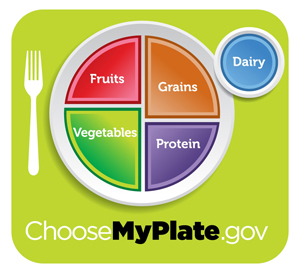NSU Newsroom
SharkBytes
Horizons
This version of NSU News has been archived as of February 28, 2019. To search through archived articles, visit nova.edu/search. To access the new version of NSU News, visit news.nova.edu.
This version of SharkBytes has been archived as of February 28, 2019. To search through archived articles, visit nova.edu/search. To access the new version of SharkBytes, visit sharkbytes.nova.edu.
Want to eat healthier? Try the new USDA MyPlate Method
Submitted by: Marilyn Gordon, Ed.D., RD, CSSD, LDN
Registered Dietitian, Certified Specialist in Sports Dietetics, Licensed Dietitian/Nutritionist
 Bye, bye, MyPyramid. Hello MyPlate. The United States Department of Agriculture has released the new food icon; MyPlate. “Choose MyPlate” is a simple message that anyone can decipher. The new icon correlates with the Dietary Guidelines for Americans 2010 consumer messages to increase intake of fruits and vegetables and control food portions.
Bye, bye, MyPyramid. Hello MyPlate. The United States Department of Agriculture has released the new food icon; MyPlate. “Choose MyPlate” is a simple message that anyone can decipher. The new icon correlates with the Dietary Guidelines for Americans 2010 consumer messages to increase intake of fruits and vegetables and control food portions.
The “MyPlate” dinner plate is divided into four sections and immediately you can see that half of your plate should be filled with fruits and vegetables. The other half of the plate has a separate portion each for grains and protein. There is a side circle labeled “Dairy” which could be non-fat or 1% fat milk, yogurt, cheese or substitution such as fortified soy milk. You may notice that the “Fats and Oils” group from MyPyramid has disappeared and the “Meat/Beans” group is renamed “Protein.”
The USDA makes note that “Oils” is not a food group but that oils are also essential to the diet. Added oils should be from the healthier sources such as olive, canola, peanut, walnut, and sesame. Many foods that we choose to eat have fat content. Even a chicken breast has some fat so unknowingly; we usually have ample fat (if not excessive) in the American diet. The trick is to increase the healthier fats and balance total calories so that we maintain a healthy weight. The “Meat/Beans” group was renamed to reflect the fact that protein is also abundant in non-animal sources such as beans, peas, lentils, soy foods, tofu, nuts and seeds. Vegetarians can be quite healthy and easily receive adequate protein in a non-animal based diet.
Now that I have piqued your interest, go to: www.ChooseMyPlate.gov and place your mouse over the plate icon and click away. You will learn about what foods are in each group, the portion size, and how many servings you need each day.